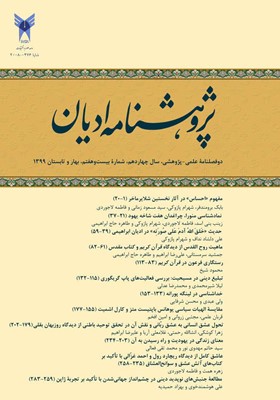خداشناسی در لینگه پورانه
محورهای موضوعی :
مسیحیت
ولی عبدی
1
*
 ,
محسن شرفایی
2
,
محسن شرفایی
2
1 - استادیار گروه ادیان و عرفان تطبیقی، دانشگاه فردوسی مشهد، مشهد، ایران
2 - پژوهشگر پژوهشکده علوم اسلامی، بنیاد پژوهشهای اسلامی، مشهد، ایران
تاریخ دریافت : 1399/09/28
تاریخ پذیرش : 1399/09/28
تاریخ انتشار : 1399/06/01
کلید واژه:
شیوه,
شکتی,
لینگه پورانه,
ویاسه,
چکیده مقاله :
لینگه پورانه جزء پورانه های شیوایی محسوب می شود و بنابراین خدای شیوه در این متن محوریت دارد. ویژگی ها، تجلیات و صور هشتگانه، بزرگی و عظمت شیوه نسبت به سایر ایزدان در لینگه پورانه مورد اشاره قرار گرفته است. افزون بر این، ایزد شیوه در این متن به صورت لینگه (قضیبی) پرستش شده است. البته در این پورانه غیر از شیوه از ایزدان دیگر هم سخن به میان آمده است، اما همه آنها تجلیات شیوه و بنابراین تابع او هستند. اگر بتوان با رویکردهای خاصی به الوهیت در لینگه پورانه نگریست، باید گفت که تعدادی عبارات در این متن به نوعی حاکی از دیدگاه توحیدی هستند؛ یعنی شیوه را خدایی واحد و متعالی معرفی می کنند. تعدادی دیگر نشاندهندة نگرش هنوتئیستی هستند، چرا که در کنار سایر خدایان، از برتری شیوه سخن به میان آمده است. اما در عین حال، نگرش غالب در آن نگاه وحدت وجودی است؛ چرا که همه جهان (عالم کبیر) و حتی انسان (عالم صغیر) بدن شیوه است. همه چیز از اوست و همه چیز اوست و همه چیز به او باز می گردد. او هم متعالی و هم ساری و جاری در جهان است.
چکیده انگلیسی:
The Linga Puranas are included in Siva Puranas, so the God Siva has occupied an important place in these Puranas. Linga Puranas have focused on the characters, manifestations, eightfold forms, and superiority of Siva. Moreover, in these texts, the phallic form of Siva is worshiped. On the basis of various approaches towards Divinity, one can claim in the Linga Puran there are some verses which concentrate on Monotheism, i.e., describe the Siva as one and transcendent God. At the same time, some other verses imply a Pantheistic approach, for the whole university (macrocosm) and even all of the men (microcosm) are considered as Siva’s body. All thing issue from Him, He is all thing and all thing will return towards Him. He is both transcendent and imminent. we will try to show the relation between God and cosmos.
منابع و مأخذ:
ایمانی، محمدرسول، «بررسی مهمترین مؤلفههای جهان بینی هندویی در متون پورانهای»، معرفت ادیان، سال اول، شماره چهارم، 1389ش.
همو، «طرحی از نظام خداشناسی آیین هندو در ویشنوپورانه»، معرفت ادیان، سال هفتم، شماره اول، 1394ش.
همو، «مقایسۀ نظام خداشناسی اسلام و آیین هندو در بحارالأنوار و ویشنوپورانه»، پایاننامه دکتر، با راهنمایی علی موحدیان عطار، دفاع شده در مؤسسة آموزشی و پژوهشی امام خمینی(ره)، 1394ش.
موحدیان عطار، علی، مفهوم عرفان، دانشگاه ادیان و مذاهب، 1388ش.
جلالی نائینی، محمد رضا (مترجم)، ریگ ودا، انتشارات علمی و فرهنگی، 1372ش.
سیمن، ویتمن، آیین هندو، علی موحدیان عطار، قم، مرکز مطالعات و تحقیقات ادیان و مذاهب، 1382ش.
شرفایی، محسن، «جهانشناسی پورانهای: ویشنو پورانه و وایو پورانه، در مقایسه با جهانشناسی قرآنی»، پایاننامه دکتری به راهنمایی دکتر ابوالفضل محمودی، دفاع شده در دانشگاه علوم و تحقیقات تهران، 1395ش.
شرفایی، محسن و ابوالفضل محمودی، «بررسی ادبیات پورانهای در دین و فرهنگ عامة هندو»، فصلنامه مطالعات شبه قاره دانشگاه سیستان و بلوچستان، سال هفتم، شماره بیست و نهم. 1395ش.
Bailey, Grey, “Puranas”, Encyclopedia of Hinduism, Ed. By, Denise cush and others, Routledge, 2010.
Banerjea Jiten, “The Hindu Concept of God”, The Religion of the Hindu, Ed. By, Kenneth w. Morgan, New York, 1953.
Bhattacharya, Barjamadhava, Saivism and the Phallic World, New Delhi, Munshiram Manoharlal Publishers Pvt Ltd, vol.1, 1993.
Bhattacharyya, Narendra Nath, Indian Religious Historiography, New Delhi, Munshiram Monohalal Publishers, vol.1, 1996.
Idem, History of Indian Cosmogonical Ideas, New Delhi, Munshiram Manharalal, 1971.
Conio, Caterina, “Puranas”, Encyclopedia of Religion, By, MircaEliade, New York, Macmillan, vol.12, 1987.
Dasgupta, Surendranath, A History of Indian Philosophy, London, Cambridge University Press, vol.1-5, 1922-1925.
Dowson, John, A Classical Dictionary of Hindu Mythology and Religion, Geography, History and Literature, London, 1961.
Eliot, Sir Charles, Hinduism and Buddhism: An Historical Sketch, London, Cruzon Press, vol.2, 1998.
Flood, Gavin, “Śaiva”, The Hindu World, Ed. By, Sushil Mittal & Gene Tursby, London & New York, Routledge,
j, Visnuism and Sivaism, New Delhi, 1996.
Jacobs, Stephen, Hinduism Today, London, Continuum International Publishing Group, 2010.
Kloetzli, W. Randolph, “Ptolemy and Purana: God’s Born as Men”, Indian Philos, no.38, 2010.
Kramrisch, Stella, “Siva”, Encyclopedia of Religion, Ed. By Mircea Eliade, New York and London, 13, 1987.
Mani, Vettam, Puranic Encyclopaedia, Delhi, Motilal Banarsidass, 1975.
Pargitter, F.E, “Purānas”, Encyclopedia of Religion and Ethics, Ed. By, James Hastings, Edinburgh,10, 1918.
Rapson, E.J, The Cambridge History of India, Ed. By, E.J Rapson, London, Cambridge At the University Press, vol.1, 1922.
Rocher, Ludo, A History of Indian Literature: The Puranas, Wiesbaden, Harrassowitz, vol.2, 1986.
Smith, Travis, “Siva”, Encyclopedia of Hinduism, Ed. By Denise cush and others, Routledge,
The Linga Purānas, Tr. By, A Board of Scholars, parts1&2, first pub. Delhi, 1973.
Werner, Karel, A Popular Dictionary of Hinduism, Curzun, 1997.
Zimmer, Heinrich, Myths and Symbols in Indian Art and Civilization, Ed. By, Joseph Campbell, Washington, Bollingen Foundation, 1946.
Wilson, H. H, The Vishnu Purana, A system of Hindu mythology and tradition, oxford, 1840.
_||_

